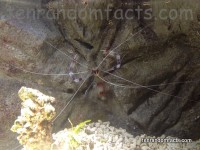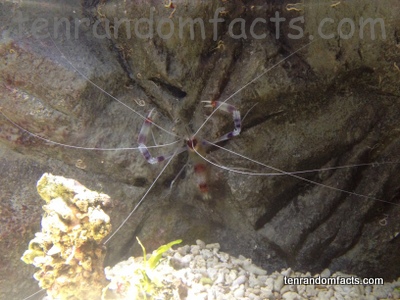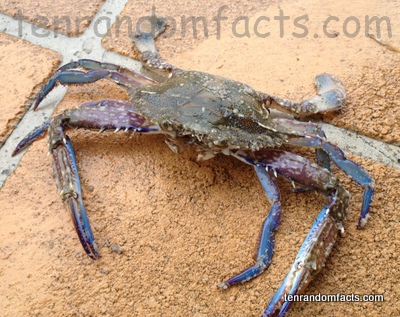
Banded coral shrimps keep the tank clean.
- Banded coral shrimps are an aquatic cleaner shrimp native to mostly tropical waters, including the west Atlantic ocean and the Indo-Pacific.
- The scientific name of a banded coral shrimp is Stenopus hispidus, and it is from the family Stenopodidae, a family of decapod crustaceans.
- ‘Banded coral shrimps’ are also known as ‘banded cleaner shrimps’ and ‘redbanded coral shrimps’, though technically they are neither prawns nor shrimps and are closer relatives to crabs and lobsters.
- Banded coral shrimps are striped in vivid reds and whites; however the shrimp’s base ‘colour’ is transparent, and the length of their body generally reaches 5 to 6.2 centimetres (2 to 2.4 inches).
- Banded coral shrimps have lengthy, white antennae that extend beyond the length of their body, and they have small spines on parts of their body.
- With their claws, banded coral shrimps clean other aquatic species bodies and mouths as part of their food intake, and they market their fish-cleaning services through a little dance and the movement of their antennae.
- Coral reefs are the natural habitats of banded coral shrimps, where they are found in waters up to 210 metres (689 feet) deep, but they generally live at much shallower depths in caves or crevices; and groups of shrimps will tend to congregate at what are called ‘cleaning stations’.
- The diet of banded coral shrimps consists primarily of dead tissue, parasites, and unwanted food, that has been scavenged from their cleaning work, though worms, crustaceans, and other marine animals are sometimes consumed.
- If a section of a body of a banded coral shrimp is lost, it will usually regenerate back on the next moult, which occurs once every month or two.
- Banded coral shrimps typically partner for life or many years, and they are somewhat territorial, remaining in the one small area for a lengthy period.
Bibliography:
Banded Coral Shrimp, n.d, World Association of Zoos and Aquariums, http://www.waza.org/en/zoo/choose-a-species/invertebrates/other-aquatic-invertebrates/stenopus-hispidus
Coral Shrimp – Coral Banded Shrimp, n.d, Fishlore, http://www.fishlore.com/Profiles-CoralBandedShrimp.htm
Sanderson A, Stenopus hispidus, 2002, Animal Diversity Web, http://animaldiversity.org/accounts/Stenopus_hispidus/
Stenopus hispidus, 2014, Wikipedia, https://en.wikipedia.org/wiki/Stenopus_hispidus








